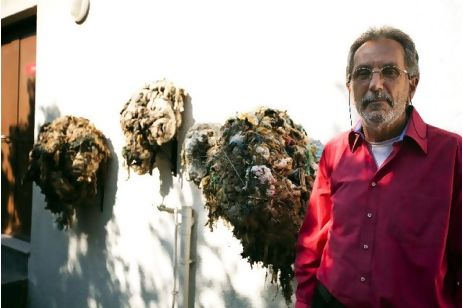 These clumps of plastic debris killed the camels from whose bellies they were retrieved.
These clumps of plastic debris killed the camels from whose bellies they were retrieved.
I’m not going to beat around the bush: I loathe plastic bags. There are many reasons, chief of which is the impact they have on our domestic and wildlife. Months ago we reported that camels were discovered to have been killed – slowly and painfully – by ingested plastic bags that eventually grew into giant rocks of plastic.
In addition to the UAE, Syria has attempted to curb the country’s plastic bag habit, but progress is slow to take root. Equally frustrated, one American designer intends to place a 30kg lump of plastic, taken from a camel’s stomach, in the center of an upcoming art exhibition designed to clamp down on the use of plastic.
An artist and assistant professor of design at the University of California at Davis, Dr. Ann Savageau has been working tirelessly to encourage people to give up plastic bags. She argues that the bags are used on average for only twelve minutes, and that reusable bags can be very attractive.
With 1.13 billion kg of textile waste shipped to America’s landfills each year, there is plenty of material to create recycled, reusable bags, which is exactly what Dr. Savageau and her students have been doing. Their designs are much coveted.
These and mementos from their owners will be the source of an art exhibition that will open on 23 January, 2011 and run through 11 March the same year.
The 30kg plastic rock that was recovered in what Dr. Ulrich Wernery calls Valley of Death, will take center stage. Located in Lipsa, UAE, the Valley is where camel, cow, sheep, and goat carcasses are dumped. Dr. Wernery has discovered all manner of plastic – the heaviest clump of which weighed 50kg. These are usually recovered from inside the carcasses.
The scientific director of the Central Veterinary Research Laboratory in Dubai, Dr. Wernery told The National that the latest ball of plastic was “a sad record” but a record nonetheless.
The exhibition will also feature a giant funnel of plastic bags – which spans from the floor to the ceiling – that represents the average number of bags an American family uses each year.
“I will put in a very prominent place the camel rock that Dr Wernery found,” Dr. Savageau told the paper. “It would make our message twice as powerful.”
:: image and story via The National
More on plastic bags:
Syria Campaigns to Curb Country’s Voracious Plastic Bag Appetite
Half of UAE’s Falaj Mualla Camels Choked on Plastic Bags
Bag It Up: Inbal Limor Recycles Plastic Bags Into High Art



great post! check out http://www.ecopackstore.com for biodegradable products! their plastic bags can degrade in as little as 6 months, whereas traditional plastic bags take at least 500 years to degrade. they’re made of all natural material, so they are not harmful to the environment.
😀